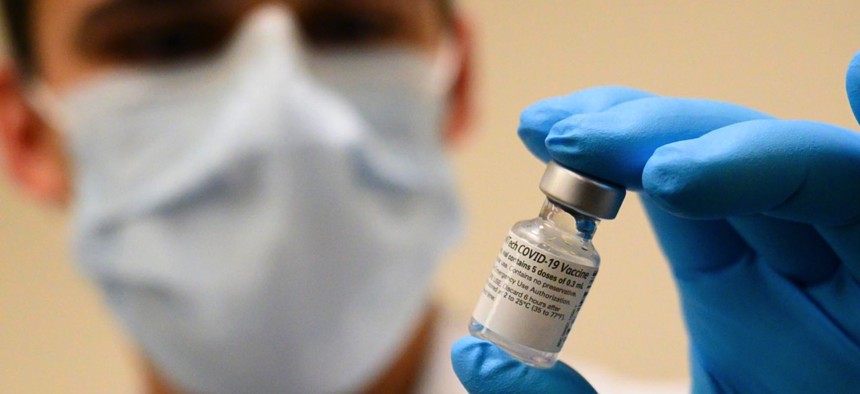
Army Spc. Angel Laureano holds a vial of the Pfizer-BioNTech COVID-19 vaccine at Walter Reed National Military Medical Center in Bethesda, Md., Dec. 14, 2020. U.S. Army
‘This May Not Be The Big One’: Army Scientists Warn of Deadlier Pandemics to Come
The service is closing in on a “pan-coronavirus” vaccine and on synthetic antibodies that could protect a population before spread. But that may not be enough.
The U.S. Army scientists who have spent the last year finding vaccines and therapeutics to stop COVID-19 cautioned that the nation remains vulnerable to a viral pandemic—one that could be even deadlier than the current one.
Since the earliest days of the COVID-19 pandemic, the emerging infectious diseases branch at the Walter Reed Army Institute of Research has worked to develop a vaccine that would help patients fend off not only the original virus strain but also new variants.
In initial tests on monkeys, horses, hamsters, and sharks, Walter Reed’s spike ferritin nanoparticle, or SpFN, vaccine has shown effectiveness against not only the current SARS-CoV-2 variants, but also against the completely different SARS-CoV-1 outbreak that occurred in 2003, the head of Walter Reed’s infectious diseases branch said at the Defense One 2021 Tech Summit Monday.
“If we try to chase the viruses after they emerge, we're always going to be behind,” said Dr. Kayvon Modjarrad, director of Walter Reed’s infectious diseases branch. “So the approach that we took with our vaccine, the nanoparticle approach, in which we can place parts of different coronaviruses on to the same vaccine to educate the immune system about different coronaviruses all at the same time.”
Walter Reed’s vaccine is now in the early stages of human trials.
“And we see the same thing over and over again: a very potent immune response and a very broad immune response,” Modjarrad said. “So if we show even a fraction of what we're seeing in our animal studies in humans, then we'll have a very good confidence that this is going to be a very good option as a next-generation vaccine.”
Dr. Dimitra Stratis-Cullum, director of the Army’s transformational synthetic-biology for military environments program at the U.S. Army Combat Capabilities Development Command, Army Research Laboratory, was tasked early on to assist the Houston Methodist Research Institute develop blood plasma as a COVID-19 therapeutic. She’s now working on developing a large dataset, a library of COVID strains that would help the lab then create and distribute synthetic antibodies to preemptively prevent a spread.
Creating a pan-coronavirus vaccine—or synthesizing antibodies slightly ahead of a known outbreak still isn’t enough, the scientists cautioned.
“We don't want to just treat what's in front of us now,” Stratis-Cullum said. “I think we really need to be resilient. From an Army perspective. We need to be agile, we need to adapt to the threat that we don't know that’s coming.”
The likelihood this generation will see another pandemic during its lifetime “is high,” Modjarrad said. “We have seen the acceleration of these pathogens and the epidemics that they precipitate. And it may not be a coronavirus, this may not be the big one. There may be something that's more transmissible and more deadly ahead of us.”
“We have to think more broadly, not just about COVID-19, not just about coronavirus, but all emerging infectious threats coming into the future,” he said.
NEXT STORY: Boeing’s Top Lobbyist Leaves Company







